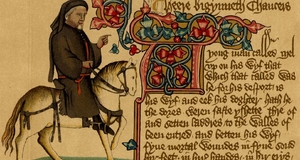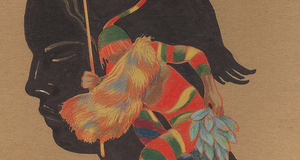The Power of the Happy Family in Tolstoy's Anna Karenina
By
2014, Vol. 6 No. 10 | pg. 2/2 | « Tolstoy emphasizes this to show how in such a difficult situation as dealing with the death of a loved one, it is so easy to fall apart. Kostya’s obsession with death puts a strain on his relationship with Nikolai because he is unable to communicate his feelings, instead feeling hopeless in comparison to the power of death: Konstantin would have said only, ‘You’re going to die, to die, to die!’ and Nikolai would have answered only, ‘I know I’m going to die, but I’m afraid, afraid, afraid!’ And they would have said nothing else, if they had spoken from the heart. [349] Since he is unable to even deal with the idea of death, Kostya is unable to be there for his brother when he needs him most, making their relationship become fake and hollow. Kitty is introduced as a naïve, emotional, and superficial character that lacks moral depth, as shown by her first impression of Nikolai Levin. Kitty and Nikolai first meet at a spa, with Kitty unaware of his identity:These were a very tall, stoop-shouldered man with enormous hands, in an old coat that was too short for him, with dark, naïve and at the same time frightening eyes, and a nice-looking, slightly pockmarked woman, very poorly and tastelessly dressed. Having recognized these people as Russians, Kitty had already begun putting together in her imagination a beautiful and moving romance about them. [216] Tolstoy makes Kitty seem like a child who sees fairytales everywhere she looks. Her close attention to detail emphasizes how much importance she puts into appearance. After she learns that these people are Nikolai and Marya Nikolaevna and hearing her mother condemn them, Kitty quickly changes her opinion: “These persons suddenly became highly disagreeable to her. This Levin, by his habit of twitching his head, now provoked in her an irrepressible feeling of disgust” (216). Rather than being sympathetic to an ill man, Kitty displays her lack of empathy by instead feeling disgust. Kitty’s first judgment of Nikolai displays how easily she is swayed by the opinions of others and how she forms opinions of others by how they look, as a child does. Although when apart Kostya and Kitty both were unable to properly handle Nikolai, after their marriage they together are able to confront death and ease Nikolai’s transition from life to death, showing the power of a happy marriage. Nikolai’s death scene reveals a new level of moral depth in Kitty. She shows selflessness and empathy when Kostya doesn’t want her to come with him to Nikolai’s death bed, but she insists, saying, “You must understand that for me to see you and not see him is much harder. There I might perhaps be of use to you and to him. Please, let me!’ she implored her husband, as if the happiness of her life depended on it” (492). Although Kitty had previously been set up as shallow character, in this scene a new side of her is revealed as she shows the depth of her love for her husband, equating his happiness with her own. Although visually Nikolai is more disgusting on his death bed than when she first saw him, she no longer sees him as an object of disgust, instead viewing him with love and compassion: “At the sight of the sick man, she felt pity for him. And pity in her woman’s soul produced none of the horror and squeamishness it did in her husband, but a need to act, to find out all the details of his condition and help with them” (493). To describe her as having a “woman’s soul” serves two purposes: it shows that Kitty is an adult, not a child, as well as showing that women have a power of sympathy and empathy that men do not possess. Using general terms such as “woman” and “husband,” rather than Kitty and Kostya, shows how Tolstoy is trying to make a generally applicable statement on men and women. Tolstoy builds upon this generally applicable idea of women as a gender who can handle death much better than men, putting it in opposition of men as thinkers: “Many great masculine minds, whose thoughts about it [death] he had read, had pondered death and yet did not know a hundredth part of what his wife and Agafya Mikhailovna knew about it” (496). Tolstoy explicitly states the interdependence of men and women, the need to find balance between the rational male mind and the emotional female soul. Although Kostya’s over-thinking mind and Kitty’s impulsivity in following her impressions and emotions are flaws when they are alone because they reach extremes, together they become balanced so that they can handle any situation. The very same traits that made Kitty disgusted with Nikolai before make her able to care so well for him as he dies because she is in love with Kostya. By blatantly setting up the juxtaposition between Kostya’s reaction to his brother’s death before and after he is with Kitty, Tolstoy reinforces the point that love makes all the difference: The sight of his brother and the proximity of death renewed in Levin’s soul that feeling of horror at the inscrutability and, with that, the nearness and inevitability of death, which had seized him on that autumn evening when his brother had come for a visit. The feeling was now stronger than before; he felt even less capable than before of understanding the meaning of death, and its inevitability appeared still more horrible to him; but now, thanks to his wife’s nearness, the feeling did not drive him to despair: in spite of death, he felt the necessity to live and to love. He felt that love saved him from despair and that under the threat of despair this love was becoming still stronger and purer. [504] While Tolstoy acknowledges that the weakness of Levin’s over-thinking still exists, his wife makes him able to see a higher purpose in life, a reason to go on, a reason to use his overactive mind and heart for good. Not only does Kitty make him better able to handle Nikolai’s death, but she also gives him a reason to live. Tolstoy uses the life and death of Nikolai Levin as a vehicle for talking about the dependence of men and women on one another. Tolstoy illustrates this larger idea through the way that Kostya and Kitty need each other to cope with Nikolai’s death, a topic they previously could not handle on their own. Since he starts the novel with “All happy families are alike” (1), he attempts to makes this statement on how men and women need each other a universal truth about all happy families. ReferencesTolstoy, Leo, Richard Pevear, and Larissa Volokhonsky.Anna Karenina: A Novel in Eight Parts. New York, NY: Penguin Books, 2002. Print. Suggested Reading from Inquiries Journal
Inquiries Journal provides undergraduate and graduate students around the world a platform for the wide dissemination of academic work over a range of core disciplines. Representing the work of students from hundreds of institutions around the globe, Inquiries Journal's large database of academic articles is completely free. Learn more | Blog | Submit Latest in Literature |













